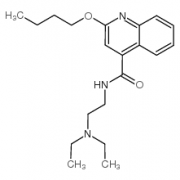
一、物性数据
1. 性状:不确定。
2. 密度(g/mL,25/4℃):不确定
3. 相对蒸汽密度(g/mL,空气=1):不确定
4. 熔点(ºC):不确定
5. 沸点(ºC,常压):不确定
6. 沸点(ºC,5.2kPa):不确定
7. 折射率:不确定
8. 闪点(ºC):不确定
9. 比旋光度(º):不确定
10. 自燃点或引燃温度(ºC):不确定
11. 蒸气压(kPa,25ºC):不确定
12. 饱和蒸气压(kPa,60ºC):不确定
13. 燃烧热(KJ/mol):不确定
14. 临界温度(ºC):不确定
15. 临界压力(KPa):不确定
16. 油水(辛醇/水)分配系数的对数值:不确定
17. 爆炸上限(%,V/V):不确定
18. 爆炸下限(%,V/V):不确定
19. 溶解性:不确定。
一、物性数据
1. 性状:不确定。
2. 密度(g/mL,25/4℃):不确定
3. 相对蒸汽密度(g/mL,空气=1):不确定
4. 熔点(ºC):不确定
5. 沸点(ºC,常压):不确定
6. 沸点(ºC,5.2kPa):不确定
7. 折射率:不确定
8. 闪点(ºC):不确定
9. 比旋光度(º):不确定
10. 自燃点或引燃温度(ºC):不确定
11. 蒸气压(kPa,25ºC):不确定
12. 饱和蒸气压(kPa,60ºC):不确定
13. 燃烧热(KJ/mol):不确定
14. 临界温度(ºC):不确定
15. 临界压力(KPa):不确定
16. 油水(辛醇/水)分配系数的对数值:不确定
17. 爆炸上限(%,V/V):不确定
18. 爆炸下限(%,V/V):不确定
19. 溶解性:不确定。
1、急性毒性:
小孩口径LDLO; 50mg/kg;
大鼠腹腔LD50:7mg/kg;
小鼠腹腔LD50:24500 ug/kg;小鼠皮下LD50:28500 ug/kg
小鼠静脉LDL0:6mg/kg
兔子皮下LD50:8500 ug/kg;兔子静脉LD50:2100 ug/kg;
猪皮下LDL0:112mg/kg
青蛙脊柱LDL0:4mg/kg
五、分子性质数据:
1、 摩尔折射率:103.27
2、 摩尔体积(m3/mol):320.4
3、 等张比容(90.2K):819.0
4、 表面张力(dyne/cm):42.6
5、 极化率(10-24cm3):40.94
1.疏水参数计算参考值(XlogP):无
2.氢键供体数量:1
3.氢键受体数量:4
4.可旋转化学键数量:10
5.互变异构体数量:2
6.拓扑分子极性表面积54.5
7.重原子数量:25
8.表面电荷:0
9.复杂度:387
10.同位素原子数量:0
11.确定原子立构中心数量:0
12.不确定原子立构中心数量:0
13.确定化学键立构中心数量:0
14.不确定化学键立构中心数量:0
15.共价键单元数量:1